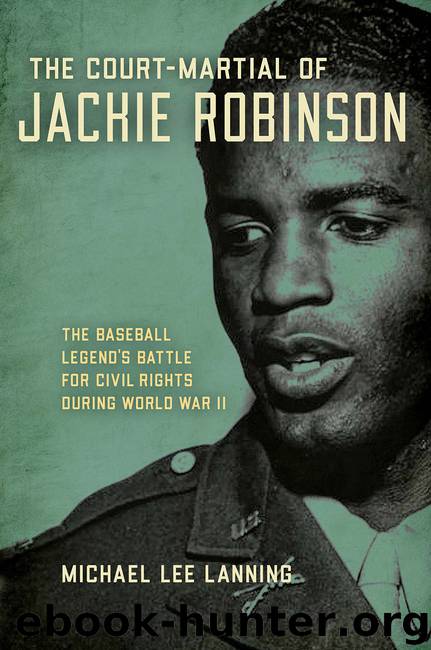The Court-Martial of Jackie Robinson by Michael Lee Lanning

Author:Michael Lee Lanning
Language: eng
Format: epub
Publisher: Stackpole Books
Published: 2019-12-19T16:00:00+00:00
• 23 •
Federal Bureau of Investigation
By the end of the 1947 Major League Baseball season, Jackie Robinson stood as the best known and most respected African American in the country. Within the black community his popularity exceeded that of boxer Jack Johnson, rivaled that of Joe Louis who still reigned as heavy-weight champion, and eclipsed that of entertainers like Cab Calloway and Count Basie. In a national-wide poll, Jackie’s popularity topped that of President Harry Truman, generals Dwight Eisenhower and Douglas MacArthur, and comedian/actor Bob Hope. According to the poll, the only person in America, white or black, whose popularity was greater than Jackie’s was the country’s first multimedia star, Bing Crosby, who led record sales, radio ratings, and motion picture grosses from 1931 to 1954. In addition to dozens of front-page photos on sports publications, Jackie appeared on the cover of Time magazine on September 22, 1947.
The post-season of his first year in Major League baseball also presented the opportunity for Jackie to make some money. Jackie had signed with Rickey for the Major League minimum salary of $5,000—more than $58,000 in today’s dollars. There had been no bonuses during or at the end of the season. During the year, he, Rachel and Jackie, Jr., had lived in a single room in a hotel, and before the gift of the Cadillac had used public transportation. Rickey had prevented Jackie from making outside appearances or endorsing any products during the season.
Once the World Series concluded, it was time for Jackie to start making some real cash. He signed with the General Artists Corporation of Manhattan and soon appeared on billboards, in magazines, and on radio and television praising products such as bread, milk, and cigarettes as the first black representative of products aimed at both white and black consumers. His endorsement of Old Gold cigarettes drew some criticism. Jackie did not smoke, but in the early post-war years seemingly every other American did.
Jackie’s first autobiography, written with Wendell Smith of the Pittsburgh Courier, came out in early 1948. The thin paperback, with the cover price of only $1 made Jackie’s story affordable to everyone. Unfortunately, in the rush to write and publish the book, Jackie apparently did not have time to proof the final version as written by Smith. In addition to other errors, it has Jack’s name as John and his mother’s name as Mollie rather than Mallie.
There were also preliminary talks and even contracts for the production of a motion picture about Jackie’s life, but it would be several more years before his story came to the screen. Although it added little or nothing to his reputation, it did increase his bank account and Jackie went on a four-week vaudeville tour across the country. After the performance by various singers, dancers, and comedians, Jackie took the stage to answer a series of scripted questions.
Jackie also spoke at testimonial dinners, civic club meetings, charity events, and National Association for the Advancement of Colored People (NAACP) gatherings. The Alameda County
Download
This site does not store any files on its server. We only index and link to content provided by other sites. Please contact the content providers to delete copyright contents if any and email us, we'll remove relevant links or contents immediately.
Becoming by Michelle Obama(9760)
The Last Black Unicorn by Tiffany Haddish(5417)
Beartown by Fredrik Backman(5368)
Man's Search for Meaning by Viktor Frankl(4294)
The Book of Joy by Dalai Lama(3701)
In a Sunburned Country by Bill Bryson(3374)
The Five People You Meet in Heaven by Mitch Albom(3337)
Full Circle by Michael Palin(3270)
The Choice by Edith Eva Eger(3216)
The Mamba Mentality by Kobe Bryant(3099)
The Social Psychology of Inequality by Unknown(2770)
Book of Life by Deborah Harkness(2723)
Imagine Me by Tahereh Mafi(2695)
The Checklist Manifesto by Atul Gawande(2661)
Less by Andrew Sean Greer(2574)
A Burst of Light by Audre Lorde(2350)
The Big Twitch by Sean Dooley(2320)
No Room for Small Dreams by Shimon Peres(2240)
No Ashes in the Fire by Darnell L Moore(2212)
